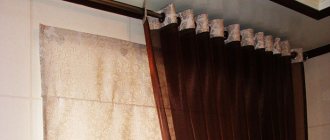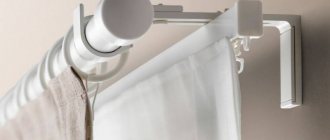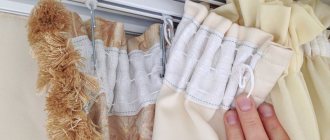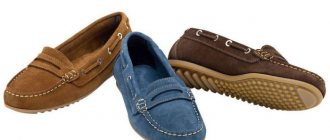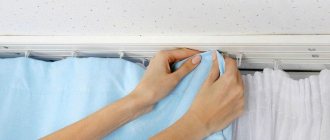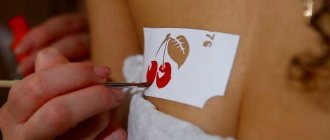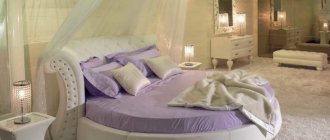Curtains are one of the most common accessories for window decoration. They allow you to complete the room, as well as a certain zest, and set the overall mood. You can achieve the desired effect even if you have a limited budget. Curtain fasteners are an important component. When choosing, you should pay special attention to the functionality, convenience and appearance of the decorative element.
There are different ways to attach curtains to the cornice. This largely depends on the preferences of the owner of the premises. The type of cornice is also a determining factor.
The curtain is secured in various ways. It all depends on the capabilities and individual preferences of the owner. In this article we will look at popular technologies, as well as the most creative solutions for rooms of different styles.
Unfortunate little things can ruin any composition, and window decoration is no exception.
What should you pay attention to before purchasing?
Curtain fasteners are a very important component when decorating. It can completely change the impression of the canvas. Therefore, you should carefully consider your choice.
The first thing you should pay attention to is the overall style. We should not forget about the type of cornice and the density of the material. For example, if you decide to attach curtains to the ceiling, ribbons or hooks will work better here.
In the vast majority of cases, they are attached to a ceiling or wall cornice.
Some types of fastenings allow the material to remain straight, while others allow it to fall in waves. In some rooms, the rigor of the design is most important, while in others some liberties are allowed.
An incorrectly chosen fastening can negate the entire attractiveness of the curtains and disrupt the stylistic unity of the interior.
You should think in advance about what you want the design to look like. Decide whether it should be heavy or lighter. Please note the following recommendations:
- select fasteners for curtains to the wall at the renovation stage;
- compliance with the overall interior must be maintained;
- if you have a cornice installed, it should match the color scheme of the furniture or covering;
- for fastening you can use rings, tapes, loops, clips;
- for low ceilings, it is best to attach curtains to the ceiling, which will give the room a more spacious look;
- It is recommended to attach heavy materials to more durable structures (for example, made of metal);
- It is recommended to decorate narrow windows with a semicircular cornice.
Attachments for curtains to the curtain rod are selected based on the design of the curtain rod itself, the density, texture and color of the fabric, as well as the characteristics of the curtain model.
Ties
Curtains, which are attached with ties, are sewn from any fabric. They are attached to the cornice with ribbons, which are tied with a bow. If the curtains are made of heavy fabric, it is better to make the ties wider. This will prevent the knots from untying and the curtains from falling.
This type of fastening is used for products with low mass. Also, ties will look great with curtains made from natural fabrics. It would also be good to combine such a fastening with curtains on which a floral pattern is made. They are usually hung in the nursery. Externally, the curtains create the impression of lightness and airiness.
Features of fastening and installation
When answering the question of what curtains are attached to, we can highlight several key concepts: wall and ceiling structures. The last option is used in cases where it is impossible to attach the structure to the wall because the room is too low.
Typically, installation limitations include fragile plasterboard walls or insufficient space for a wall cornice.
Note! In the last few years, stretch ceilings have become widespread. This is a modern way to decorate a room. They are also equipped with small hooks to which curtain materials are attached.
Curtains with hinges
One of the options for attaching curtains is fabric loops
If you are interested in more modernized methods of fastening, pay attention to curtains with hinges. The main condition is that the loops are made of the same material as the curtain fabric (photo).
You can make such curtain mounts yourself
Using curtains with hinges eliminates the question of choosing a curtain rod, since they can be secured to a rod of any profile.
Loops for cornices can be made in the form of rings, bows, knots
There are two types of loops:
blind or solid - sewn to the fabric at both ends; with unfastening - a fastener in the form of a button, Velcro or button is attached to the free edge of the loop.
Before choosing such an option, you should think about how it will fit into the overall design of the room.
How to hang curtains? Everything is very simple - the cornice is threaded through the loops along the entire width of the curtain. Curtains with hinges can be designed in different ways. Many housewives experiment and tie loops in the form of bows, knots or rings.
Advice! When decorating an office or living room, it is better to use more laconic fasteners. But for a child’s room or bedroom, curtains with loops are ideal.
Loops for the curtain rod are made from the same fabric as the curtains, but you can use ribbons or braid
A few more advantages :
- curtains with hinges can be decorated with your own hands;
- Even professional products have affordable prices.
It should be remembered that when decorating curtains with hinges, it is better to choose an elastic material. Otherwise, it simply won't slide.
Basic fastening methods
There are several ways to attach curtains. Each of them is used in different cases depending on the arrangement of the room. It is recommended to consider the following options.
- To the cornice. A classic method that has been used for many years. There is a wide range of products on the market.
Installation is possible on a wall or ceiling, depending on the owner’s decision. - Without cornice. If you don’t know how to attach curtains without a cornice, then it is recommended to consider this option. Curtains or blinds are attached directly to the wall, window frame or ceiling.
A special rope, hooks, tapes or other structures can be used. It all depends on the imagination and capabilities of the apartment owners.
Material
The material used to make rings varies. It can coincide with the material of the cornice strip or, on the contrary, differ sharply, for example, when metal rings are put on a wooden cornice.
Cornice rings are usually made from the following materials:
- Plastic. Many options for fastening rings are made from plastic, both imitating other materials (usually made “like wood”), and with an emphatically plastic structure, which has a wide range of colors and different degrees of transparency. You can hang any curtains of suitable design on them. Depending on the model of the cornice, plastic rings will look appropriate in a nursery, kitchen or living room.
- Tree. Wooden rings for curtains on cornices will be appropriate in rooms furnished in a classic or antique style. For wooden rings, it is not advisable to take a curtain rod made of another material - they will look stylish only on wooden structures, especially if plain curtains made of noble fabrics are hung on them.
- Metal. A curtain holder with metal rings can be hung, depending on the model, both in rooms with a modern style and in imitation of antiquity (forged models of holders). You can hang curtains on them using any of the methods below on how to attach curtains to rings.
Selecting a location
You can install the mount yourself anywhere. Let's look at the most common options.
- Ceiling. One of the simplest and most common methods. Suitable for rooms with low ceilings, as well as for visually enlarging a room.
- Wall. Classic type of fastening. Here you can install almost any available structure. This could be a barbell or other element. Excellent for heavy fabrics.
- Casement. Typically used to secure blinds. Also suitable for bamboo or roll fabrics.
- Frame. It is assumed that such a structural element is used to attach miniature curtains.
It’s easy to get lost in the variety of accessories. Sometimes curtain rod manufacturers make the task easier and sell the fasteners as a set.
Original design options
The variety of tulle designs allows you to use different design methods depending on the design of the room, its purpose, the appearance of the curtains and personal tastes:
Laconic tacks
- In narrow rooms, it is correct to hang tulle with horizontal stripes. In rooms with low ceilings - with vertical ones. In so-called “wells” (small rooms with an excessively high ceiling) - hang a lambrequin on tulle. In this way, you can compensate for design deficiencies.
- The use of organza allows you to completely transform the window design. The types of this fabric are distinguished by their unusual appearance: the fabric is produced with shine, matte, with woven metal threads and other options. The “chameleon” effect, in which the organza changes color depending on the viewing angle, is sure to attract the attention of guests. This design will create a solemn holiday atmosphere.
- The use of a spacer spring cornice allows you to beautifully hang tulle in the kitchen right in the window opening without damaging the slopes. In addition, you can change the location of such a structure, hang or remove the fabric for washing in a matter of minutes.
- Using tiebacks, you can adjust the height of the tulle, the depth of the folds and beautifully hang tulle and curtains, creating a single asymmetrical composition.
- Tulle is easy to work with, so creating a fancy shape for the bottom edge or drawstring is quite easy. The lower edge can be cut in the shape of a semicircle and hemmed with openwork lace, and an interestingly designed figured drawstring is quite capable of performing the decorative functions of a lambrequin.
- In combination with ordinary curtains or instead of them, muslin, a curtain consisting of individual cotton threads, is used.
- A combination of fabrics of different colors allows you to beautifully hang tulle in the bedroom. At the same time, given that transparent or translucent fabric is used, at the intersection of the canvases, the overlay of colors will form another color.
Fastening without cornice
The following types of construction should be distinguished.
- Universal brackets. A convenient element for fastening curtains, takes up little space. Also used to secure blinds.
The curtain strip is secured using brackets attached to the wall. - Velcro. Suitable for those rooms where a minimum amount of natural sunlight is required.
With this fastening, there is a minimum distance between the window and the curtain. - Self-tapping screws. A very simple and accessible method.
- Double sided tape. Not the most reliable method, but it will do if there are no other materials at hand.
Types of cornices
How the curtains will look in the interior of the room depends primarily on the chosen model of the cornice, its location relative to the window opening and the method of attaching the tulle. According to the method of fastening, cornices are divided into two types:
- Wall-mounted. Installed on the wall above the window, it is important to maintain the distance to the upper edge of the window opening - when opening, the window should not touch the tulle cornice. You can hang the cornice on the wall using self-tapping screws, consoles or brackets.
- Ceiling. Attached to the ceiling surface using self-tapping screws, they allow you to decorate the window opening and the wall along the entire height, without leaving a gap in the upper part.
Fastening to suspended ceilings and plasterboard has some peculiarities: a wooden beam is installed under the suspended ceiling at the installation stage, to which the fasteners are made; fastening to plasterboard is distinguished by the use of spacer dowels (“mollies”), which prevent falling out.
To decorate window openings located in a niche, cornices are installed perpendicular to the plane of the window opening.
Also, curtain rods differ in the way curtains are attached:
- Strings. Designed for installation on a metal string or fishing line for curtains made of light fabrics; over time, the tension of the string weakens, which leads to sagging curtains.
- Profile. Made from plastic or aluminum profile. At the bottom of the profile there are several (from one to three) rows of grooves into which the required number of hooks are inserted (hooks for ceiling cornices are supplied complete with the profile) for fastening the canvas. You can hang the tulle on hooks using curtain tape with ready-made loops. To form curved structures, additional rotation angles of 45° or 90° are acquired.
- Baguettes. According to the principle of operation, they do not differ from profile cornices, but have a more noble design.
- Round. Fasteners are installed on a round rod.
To fasten some types of lifting curtains, other curtain rods are used, which differ in the method and location of fastening (the cornice for fabric blinds is a closed box with a lifting mechanism and can be mounted on a wall or window profile). To install Roman, Austrian and French curtains, use a French cornice equipped with a chain for adjusting the curtains.
Varieties
The type of fastening is selected depending on various characteristics. This is influenced by the type of room, as well as the personal preferences of the owners.
Hooks
A budget option available to everyone. They are easy to install. Capable of holding almost any type of fabric. It has a good appearance and will fit into any interior.
Hooks are available in metal and plastic.
Curtain tape
A fairly simple way to secure curtains. Buy any ribbon and thread it through the holes of the fabric, forming a drapery. Depending on the type of material, the ease of moving the curtain along the curtain rod may differ.
Curtain tape makes it easier to place curtains on hooks or rings and allows you to create unusual folds.
Note! To make the curtains look voluminous, the canvas should be several times wider than the cornice.
Characteristic features of the option under consideration:
- suitable for modern plastic fasteners without unnecessary decorative elements;
- availability;
- suitable for different types of curtains;
- can be used for many years.
Curtain tapes are made of cotton and nylon. Not only sewn ones are produced, but also several types of adhesive ones.
Rings
The simplest and most common option. Actively used with ribbons and hooks to give an interesting appearance.
Main advantages:
- suitable for round curtains;
- have a long service life;
- Suitable for all types of installations.
It should be noted that such structures are difficult to disassemble and assemble due to the large number of small parts.
A convenient and aesthetically attractive way to attach curtains. The fittings are often sold together with the cornice.
Eyelets
It is fastened through holes in the fabric, also called eyelets. Stylish and attractive option. Rings are made of metal or plastic depending on the situation. Built directly into the fabric. Such structures are almost impossible to destroy.
Note! Designers recommend that the color of the eyelets be in harmony with the color scheme of the cornice and the furniture in the room to create a unified image.
As a rule, curtains with such fastenings are made to order. Pairs perfectly with dense, heavy fabrics.
Curtain drawstring: what is it?
A fairly simple, but no less effective option. It is a pocket stitched directly into the fabric. A cornice is threaded through it. These curtains are very easy to put on and take off.
The main advantage is the absence of noise when moving. The cost of such a design is affordable for most buyers.
The drawstring will withstand heavy fabric, but it looks much more beautiful on tulle or thin curtains made of natural fabric.
Curtains with hinges
One of the modern options. Choose loops that match the fabric. This makes it possible to attach the curtain to any rod. Experiment with different types of designs.
Note! For offices, a more restrained style is recommended. But in the nursery or bedroom you can experiment.
Loops, like the drawstring, are easy to make with your own hands. They will decorate rooms not intended for prying eyes.
Clamps
One of the universal and oldest methods. Allows you to easily secure almost any fabric.
Clips are not recommended for use on curtains that are too heavy.
Curtain tape
Curtains have not only a functional load, but also an aesthetic one.
Fixing curtains with curtain tape (braid) is quite simple to do. All you need to do is buy some ribbon, sew it on the inside of the fabric and hang the curtains. The braid gathers the fabric, forming a beautiful drapery. The tightening density can always be changed in the future. In the photo you can see what fastening with curtain tape looks like.
The hooks can be hidden behind the fabric, and a special curtain tape with cords that act as loops can be attached to the edge of the curtain.
Remember that depending on the type of fabric, hinged curtains may not move easily along the curtain rod, so experiment with the material before making your final decision.
The braid can be different: transparent and dense, with one or two rows of loops. The choice depends on the weight and severity of the material from which the curtains are made.
Curtain tape is used in conjunction with different types of fastenings, but most often with a hook
Advice! To give special pomp and volume to the curtains, the width of the canvas should be 1.5-2 times the width of the space that needs to be draped.
Spectacular curtain with ribbon
Curtains have always been an important part of the interior
Features of fastening with tape:
- ideal for open-type cornices without decorative strips and slats;
- universal fastening, applicable for all types of curtains;
- optimal cost;
- the service life of curtain tape is almost unlimited;
Curtain fastenings should be selected individually for each curtain model
